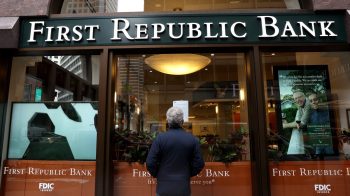Is there a flaw in the government’s plan to deal with troubled banks?
This is the headquarters of the erstwhile Californial National Bank, located in the same building complex as Marketplace. The bank was taken over by the FDIC and sold to US Bank a few weeks ago.
The WSJ reports that there could be.
The idea was, banks weighed down by toxic assets would be taken over by the FDIC and then sold to the highest bidder. But, the WSJ story says , like a lot of the toxic assets themselves, there are no bidders for many of these banks.
Some are in such bad shape that potential buyers won’t touch them at any price, even if the government agrees to eat losses on the failed bank’s bad loans. In addition to their depleted capital, many seized banks operate in areas with sluggish growth prospects, are puny and are loaded with expensive deposits gathered through brokers that are likely to leave when the acquiring bank reins in interest rates.
But the story also includes a quote from an FDIC official saying the program is working.
About 95% of banks seized by regulators have been sold. While some attract few bids, the FDIC has “had tremendous success in finding buyers,” the spokesman said.
The FDIC says 124 banks have failed this year. Calculated Risk crunched some numbers from the FDIC at the end of last week and said there are plenty more to come, with 552 banks on the official Problem Bank list at the end of Q3.
There’s plenty of talk about the ability of the FDIC fund to be able to sustain bank failures at this rate. Last month Tess Vigeland interviewed Karen Shaw Petrou about the FDIC, how it operates and whether it can survive.
Vigeland: There seems to be a lot of concern that they’re bailing out so many banks that they’re going to run out of money.
Petrou: It’s going to replenish the fund before that through the banks, but if for some reason that didn’t work, there’s always Uncle Sam. The FDIC has a half-a-trillion-dollar line of credit with the U.S. Treasury. So insured deposits at FDIC-insured institutions are very, very safe.
Not everyone is convinced, of course. Joe Wiesenthal at Clusterstock suggests letting the public buy the banks.
The FDIC could float an ETF, allowing it to raise cash, while giving the public the chance to play vulture, for once. Investing in it could be marketed as being patriotic.
There’s a lot happening in the world. Through it all, Marketplace is here for you.
You rely on Marketplace to break down the world’s events and tell you how it affects you in a fact-based, approachable way. We rely on your financial support to keep making that possible.
Your donation today powers the independent journalism that you rely on. For just $5/month, you can help sustain Marketplace so we can keep reporting on the things that matter to you.


















